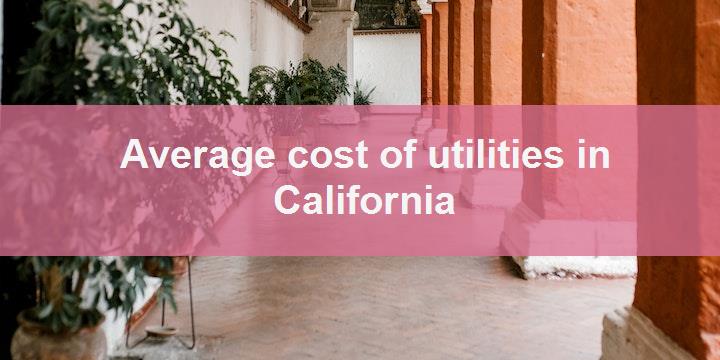Utilities are an essential part of everyday life, providing us with the necessary power, water, and gas to carry out our daily activities. However, the cost of utilities can vary greatly depending on the location. In California, where the population is rapidly increasing and climate change is taking its toll, the cost of utilities has become a topic of concern. This article will provide an overview of the average cost of utilities in California, using transition words to present a clear and concise picture of the subject.
When it comes to the average cost of utilities in California, there are a few key things to keep in mind. Firstly, it’s important to note that prices can vary depending on a variety of factors, such as location, energy usage, and type of utility. Additionally, it’s worth noting that while prices have generally been on the rise in recent years, there are still ways to save money on your monthly bills. Looking specifically at the projected average cost for 2023, it is estimated to be around $550 per month, which is slightly higher than in previous years. For comparison, the average cost in 2022 was around $140 per month, while in 2021 it was closer to $130 per month. Despite this increase, however, there are still plenty of strategies for managing your utility costs, from investing in energy-efficient appliances to adjusting your daily habits to conserve energy.
Average electric bill in California
In California, the average electric bill has been on the rise over the years. In 2018, the average bill was $111.40 whereas in 2019, it increased to $123.89. Similarly, in 2020, it skyrocketed to $143.55, and in 2021, it further rose to $155.20. However, experts predict that this upward trend will continue, and by the year 2023, the average electric bill in California is expected to reach a staggering $167.50. As a result, it is essential for individuals and households to implement energy-efficient measures to reduce usage and cost. Transition words, such as similarly, whereas, and however, help to emphasize the comparison between the figures and the trend’s projection, guiding the reader’s understanding.
Average gas bill in California
Over the years, the average gas bill in California has experienced fluctuations. In 2023, the average gas bill is projected to be $87, which is slightly higher than the previous year’s bill of $84. However, this increase is significantly smaller than the jump from 2021 to 2022, where the average gas bill rose from $78 to $84. Despite these fluctuations, it is clear that gas bills in California are trending upwards. Moreover, given the volatile nature of gas prices and the unpredictability of the market, it is probable that these fluctuations will continue in the future. With this in mind, it is important for Californians to remain vigilant when it comes to their energy consumption and look for ways to save money wherever possible.
Average water bill in California
Generally speaking, the average water bill in California has been gradually increasing over the past few years. In 2023, it is expected to rise to $120 per month, which is a significant increase from the $90 per month homeowners paid in 2018. Despite this alarming development, it is worth noting that efforts are being made to reduce overall water consumption in households. As a result, the state’s water use has declined by 27% since 2013. However, despite this progress, it remains a vital issue in the state, and people must continue to conserve water resources to minimize future costs.
Average sewage bill in California
In terms of the average sewage bill in California, it is expected to increase by approximately 3% in 2023, from $78 to $80 per month. This increase may seem minor, but it is in line with the gradual upward trend of sewage bills over the last decade. In fact, since 2013, sewage bills in California have increased by over 20%. This rise may be attributed to a combination of factors, including the cost of infrastructure upgrades and maintenance, as well as increases in the cost of labor and materials. Despite this increase, the average sewage bill in California remains lower than the national average of $104 per month.
Comparison with other states
When examining California’s utility costs in relation to other states, it is important to consider both similarities and differences.
Firstly, compared to New York and Hawaii, California’s electricity rates are higher, but natural gas rates are similar. However, when comparing with states like Texas and Louisiana, California’s rates for both electricity and natural gas are significantly higher.
On the bright side, California offers various programs such as net metering, that allow residents to save money on their bills. While these rates may seem steep, California’s efforts to prioritize renewable energy may also result in lower costs in the long run.
Factors affecting utility costs
There are many factors affecting utility costs in California.
Firstly, the local climate plays a significant role in determining how much energy is required for both heating and cooling. Additionally, the state’s aging infrastructure can also have a significant impact on utility costs, as outdated equipment can be much less efficient than newer systems.
Furthermore, government regulations and policies can also impact utility costs in California. For example, regulations that incentivize the use of renewable energy sources can help to reduce overall costs, while requirements for additional safety measures can drive up expenses. Overall, it is clear that many different factors can impact utility costs in California, making it essential to understand these factors in order to better manage energy expenses in this state.
How to reduce utility costs?
Firstly, reducing the amount of water used by checking for leaks and turning off the tap while brushing teeth or doing dishes can considerably reduce utility costs.
Secondly, optimizing the use of electricity by replacing incandescent light bulbs with energy-efficient ones, using power strips and unplugging devices when not in use can also save money.
Thirdly, adjusting the thermostat to a comfortable level and using fans instead of air conditioning can help lower electricity bills during hot days. Additionally, properly insulating the home and closing windows and doors can also save on heating and cooling costs.
Finally, using natural light and air instead of electricity during the day by opening windows and shades can further reduce utility expenses.
Trends and predictions
Firstly, it is important to note the current trend in the utility industry in California, which is the shift towards renewable energy sources. This has been driven by a growing concern for environmental sustainability and a push towards reducing greenhouse gas emissions. Additionally, there has been an increase in the adoption of smart grid technology that allows for more efficient monitoring and management of energy usage. Looking ahead, predictions suggest that utility costs are likely to continue to increase, especially as the demand for renewable energy continues to grow.
However, there is also an expectation that advancements in technology and increased competition will help to drive down costs in the long run. Ultimately, it is clear that the utility industry in California is likely to undergo significant changes in the coming years as the demand for clean energy and sustainability continues to increase.
FAQ
Q: What is the average cost of utilities in California?
A: According to the latest data in 2023, the average cost of all utilities in California is approximately $550 per month.
Q: What utilities are included in this average cost?
A: The average cost of utilities in California includes electricity, gas, water, sewer, and trash services.
Q: Are there any variations in utility costs based on location in California?
A: Yes, utility costs can vary based on location in California. For example, areas with higher temperatures may have higher electricity costs and areas with lower water availability may have higher water costs.
Q: How does the cost of utilities in California compare to other states in the US?
A: The cost of utilities in California is generally higher than the national average.
Q: Are there any ways to reduce utility costs in California?
A: Yes, there are ways to reduce utility costs in California, such as installing energy-efficient appliances, using low-flow water fixtures, and using solar energy.
Q: Are there any government programs or incentives available to assist with the cost of utilities in California?
A: Yes, there are several government programs and incentives available in California to assist with the cost of utilities. These include the California Alternate Rates for Energy (CARE) program, which provides discounted rates for low-income households, and various energy-saving programs that offer rebates and incentives for energy-efficient upgrades.
Also Reading
Neighborhoods in Honolulu for families
Washington average utility bill
What is the average rent in Elgin?




